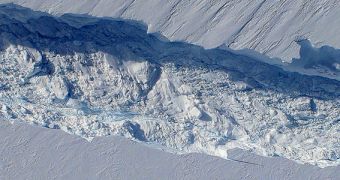An international group of researchers, including scientists from the US Department of Energy's (DOE) Lawrence Livermore National Laboratory (LLNL), discovered in a new study that the Pine Island Glacier (PIG) may continue to melt at the current, alarmingly-high rates for a few additional decades, if not even centuries. The team discovered that a similar event took place some 8,000 years ago.
The PIG flows from the south side of the Hudson Mountains into Pine Island Bay, in the Amundsen Sea, Antarctica. It is one of the five largest ice streams on the Southern Continent, draining no less than 10 percent of the entire West Antarctic Ice Sheet (WAIS). The latter is one of the fastest-melting regions at the South Pole, according to statistics gathered over the past few decades.
Some researchers have named the PIG the weak underbelly WAIS, especially after learning that its melt speed had increased by more than 73 percent between 1974 and 2007. The increase was not progressive, as around 8 percent of the boost was recorded starting in mid-2005. If the glacier melts, global sea levels will rise by around 1 to 2 meters (3 to 6,7 feet).
Even worse, the collapse of the PIG – which is estimated to occur within a century if current melt rates continue – has the potential to destabilize the entire WAIS, as well as significant portion of the East Antarctic Ice Sheet, which has thus far remained largely unaffected by global warming.
The new investigation suggests that the PIG underwent similar periods of accelerated thinning and melting in the distant past. The team says that the latest instance of such an event occurred some 8,000 years ago, when melt rates reached as high as 100 centimeters (39.3 inches) per year.
These conclusions are based on analysis of beryllium-10 concentrations in rocks transported by the PIG from the Hudson Mountains. The isotope is created when cosmic rays hit these rocks after passing through the ice above. The study was conducted using the Center for Accelerator Mass Spectrometry at LLNL, and was led by investigators Bob Finkel and Dylan Rood.
In a paper supporting the discovery, published in the February 20 issue of the journal Science Express, the research group argues that the glacier may continue to melt at current rates for decades, or even centuries, without collapsing in its entirety.
“Pine Island Glacier has experienced rapid thinning at least once in the past. Once set in motion, rapid ice sheet changes in this region can persist for centuries,” Finkel explains. At the point where the PIG leaves the ground and becomes a floating ice shelf 2002-to-2007 melt rates varied between 1.2 and 6 meters (around 4 to 20 feet) per year.
“The melting of the Pine Island Glacier at a rate comparable to that over the past two decades is rare but not unprecedented. Ongoing ocean-driven melting of the glacial ice shelf in current times may result in continued rapid thinning and ground line retreat for several more decades or even centuries,” Rood concludes.

 14 DAY TRIAL //
14 DAY TRIAL //